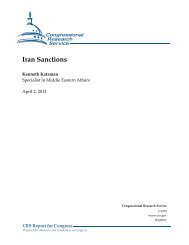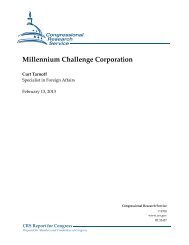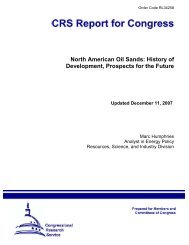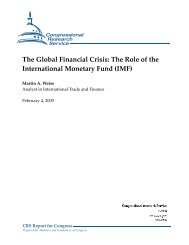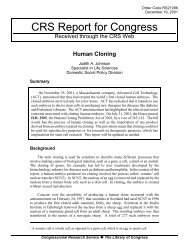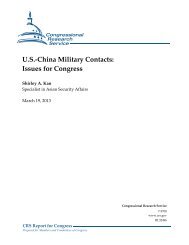The Proposed U.S.-South Korea Free Trade Agreement (KORUS ...
The Proposed U.S.-South Korea Free Trade Agreement (KORUS ...
The Proposed U.S.-South Korea Free Trade Agreement (KORUS ...
- TAGS
- korea
- fpc.state.gov
You also want an ePaper? Increase the reach of your titles
YUMPU automatically turns print PDFs into web optimized ePapers that Google loves.
79 Ibid., Table 2.2.<br />
80 Ibid., pp. 3-68 and 3-71.<br />
81 ITAC 2, p. 1.<br />
82 USITC. U.S.-<strong>Korea</strong> FTA, p. 3-71.<br />
CRS-26<br />
the US ITC’s simulation analysis, the sector stands to gain nearly $3 billion in<br />
exports if the agreement is approved. 79 <strong>The</strong> tariffs on U.S. machinery and equipment<br />
imported into <strong>South</strong> <strong>Korea</strong> range from 3% to 13%, but U.S. products are already<br />
competitive in many cases, and already account for 15-20% of total <strong>South</strong> <strong>Korea</strong>n<br />
imports. (A specific example is U.S.-made computer-numerically controlled<br />
machine tools.) Most machinery tariffs would be immediately eliminated; others<br />
would be phased out over three to ten years. 80 As noted in the previous section on<br />
autos, the capital goods machinery industry representatives in ITAC 2 split with the<br />
motor vehicle industry representatives and supported the agreement. <strong>The</strong> ITAC<br />
report specifically cited, “U.S. manufacturers of electrical equipment [who] will<br />
benefit substantially by <strong>South</strong> <strong>Korea</strong>n tariff reductions and eliminations, where the<br />
sector has already returned to running a trade surplus with <strong>South</strong> <strong>Korea</strong>.” 81 <strong>The</strong><br />
USITC report further noted the export potential of electrical-power generating<br />
equipment, for which <strong>South</strong> <strong>Korea</strong>n duties range up to 8% currently. U.S. exporters<br />
are nonetheless already leading suppliers of turbines, generators and nuclear reactors<br />
to <strong>South</strong> <strong>Korea</strong>. 82 <strong>The</strong> National Electrical Manufacturers Association (NEA) stated<br />
that U.S. exports to <strong>South</strong> <strong>Korea</strong> had risen steadily, by a total of 62%, since 2002,<br />
and that there was a U.S. surplus in bilateral trade. It calls for:<br />
legislators in both countries to ratify the <strong>Agreement</strong> as soon as possible. While the<br />
U.S. electrical equipment industry still has concerns relating to non-tariff barriers<br />
and intellectual property protection in <strong>South</strong> <strong>Korea</strong>, the overall FTA package would<br />
improve conditions for selling there by featuring the elimination — most of it<br />
immediate — of remaining tariffs on goods in NEA’s product scope. 83<br />
Another major capital goods item in which the United States has a strong bilateral<br />
trade position is aircraft. Total 2006 aircraft and parts exports to <strong>South</strong> <strong>Korea</strong> were<br />
$2.4 billion. However, civilian aircraft imports are already duty-free in <strong>South</strong><br />
<strong>Korea</strong>. 84<br />
Electronic Products and Components. Both <strong>South</strong> <strong>Korea</strong>n and U.S. tariffs<br />
on most electronics products, such as semiconductors, telecommunications<br />
equipment, and computers, are already zero, as they are included in the multilateral<br />
Information Technology <strong>Agreement</strong> eliminating tariffs among more than 50<br />
countries. <strong>The</strong> United States already has a substantial surplus with <strong>South</strong> <strong>Korea</strong> in<br />
semiconductors: $4.3 billion in 2006 exports, versus $2.9 billion in imports. <strong>The</strong><br />
United States has a small deficit in computer equipment, plus large imports of<br />
83 NEMA. “U.S.-<strong>South</strong> <strong>Korea</strong> <strong>Free</strong> <strong>Trade</strong> <strong>Agreement</strong>,” NEMA Issue Brief (April 2007).<br />
84 USITC. U.S.-<strong>Korea</strong> FTA, p. 3-68 and Table 3.13.



